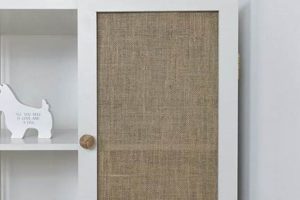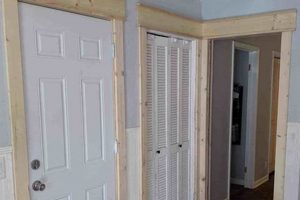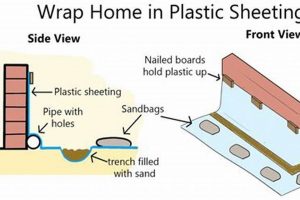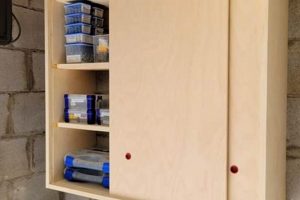An independently crafted or modified access panel for cabinetry is a frequently undertaken home improvement project. Examples range from simple replacement panels fashioned from plywood to more intricate designs incorporating raised panels, glass inserts, or custom hardware. The core concept involves individuals taking responsibility for the design, construction, and installation of these elements, rather than purchasing pre-made versions.
Undertaking such projects offers significant advantages, primarily cost savings compared to professional services or purchasing pre-fabricated units. Furthermore, it allows for complete customization, enabling homeowners to precisely match existing dcor, accommodate unique spatial constraints, or express personal aesthetic preferences. Historically, this type of self-sufficiency was born out of necessity but has evolved into a popular hobby fueled by readily available resources and a desire for personalized living spaces.
Given the project’s multifaceted nature, the following sections will delve into essential considerations. These include material selection, appropriate tools and techniques, different design approaches, and crucial finishing processes to ensure a durable and aesthetically pleasing outcome. The goal is to provide readers with the knowledge and resources necessary to successfully complete this undertaking.
DIY Cabinet Door Construction
Successful construction hinges on careful planning and execution. The following tips offer guidance for optimizing results and minimizing potential pitfalls throughout the process.
Tip 1: Accurate Measurement is Paramount. Before initiating any cuts, meticulous measurements of the cabinet opening are crucial. Account for hinge placement and any desired reveals to ensure a proper fit. Inaccurate dimensions can lead to wasted material and rework.
Tip 2: Select Appropriate Materials. Material selection directly impacts durability and aesthetics. Consider solid wood for its strength and visual appeal, or medium-density fiberboard (MDF) for its stability and paint-friendly surface. Budget constraints and desired finish will influence this choice.
Tip 3: Utilize Precise Cutting Techniques. Employ a table saw or circular saw with a guide for straight, clean cuts. A miter saw is recommended for accurate angle cuts, particularly for frame-and-panel designs. Smooth, consistent cuts contribute to a professional-looking finished product.
Tip 4: Secure and Durable Joinery is Essential. Employ reliable joinery methods such as mortise and tenon, dowels, or pocket screws to ensure structural integrity. Apply wood glue liberally to all joints and clamp securely during the curing process.
Tip 5: Prioritize Surface Preparation. Thorough sanding is critical for achieving a smooth, even finish. Start with a coarser grit sandpaper and progressively move to finer grits. Remove all dust particles before applying primer or paint.
Tip 6: Apply a High-Quality Finish. Select a paint, stain, or varnish appropriate for the chosen material and intended use. Apply multiple thin coats, allowing each coat to dry completely before applying the next. Consider a clear topcoat for added protection and durability.
Tip 7: Proper Hinge Selection and Installation are Key. Choose hinges that are appropriate for the door’s weight and thickness. Use a hinge jig to ensure accurate and consistent placement. Securely fasten the hinges to both the door and the cabinet frame.
By adhering to these tips, individuals can increase the likelihood of a successful and satisfying outcome. Careful planning, precise execution, and attention to detail are paramount for achieving professional-quality results in independently constructed units.
The subsequent sections will explore specific design styles and advanced techniques to further enhance the project.
1. Material Selection
Material selection exerts a profound influence on the functionality, aesthetic appeal, and longevity of a self-constructed cabinetry access panel. The chosen material dictates the structural integrity, workability, and finishing characteristics of the component. For instance, opting for solid hardwood, such as maple or oak, provides exceptional strength and resistance to wear, suitable for high-use areas like kitchen cabinets. However, solid wood can be more expensive and susceptible to warping or expansion in environments with fluctuating humidity levels. Conversely, medium-density fiberboard (MDF) offers a stable, cost-effective alternative. While lacking the inherent strength of solid wood, MDF provides a smooth, uniform surface ideal for painting and is less prone to movement, making it suitable for bathroom vanities. The incorrect material choice can result in premature failure, increased maintenance costs, and an undesirable aesthetic.
The selection process also necessitates consideration of the intended finish. Paint-grade materials, like MDF or poplar, are often preferred for projects where a painted surface is desired, due to their smooth, easily prepared surfaces. Stain-grade materials, such as cherry or walnut, showcase the natural grain and beauty of the wood, requiring a different approach to surface preparation and finishing. Furthermore, the hardware to be used, such as hinges and knobs, may dictate the required thickness and density of the material. For example, heavy, self-closing hinges may require a thicker, more robust material to ensure secure attachment and prevent sagging over time.
In summary, material selection represents a critical decision point in the construction of cabinetry access panels. A thorough understanding of material properties, performance characteristics, and compatibility with the intended finish and hardware is essential. Failure to adequately consider these factors can compromise the structural integrity, aesthetic appeal, and long-term durability of the finished product. The initial investment in informed material selection translates directly into a more successful and satisfying outcome, avoiding costly rework and ensuring the longevity of the cabinetry component.
2. Precise Measurement
Accurate dimensioning is paramount to the successful fabrication of cabinetry access panels. Deviations from specified measurements result in ill-fitting components, necessitating costly rework or complete replacement. The implications of imprecise measurement extend beyond mere aesthetics, impacting the functionality, structural integrity, and overall longevity of the assembled cabinet.
- Cabinet Opening Dimensions
The interior dimensions of the cabinet frame dictate the overall size of the access panel. Accurate measurement of the width, height, and squareness of the opening is essential to ensure a proper fit. Inaccurate dimensions lead to gaps, binding, or the inability to install the panel. For example, a measurement error of even 1/8 inch can render a face-frame design visibly misaligned.
- Material Thickness Compensation
The thickness of the selected material must be precisely accounted for when determining the overall size. If the material thickness is not factored in correctly, the finished access panel will either be too large or too small, preventing proper closure or creating unsightly gaps. Consider the use of shims or applied moldings, which require meticulous measurement to ensure a seamless transition.
- Hinge Placement Accuracy
Hinge placement requires exacting measurements to guarantee smooth operation and proper alignment. The distance from the edge of the access panel and the cabinet frame, as well as the vertical spacing between hinges, must be consistent and accurate. Misaligned hinges can cause binding, sagging, or complete failure of the closure mechanism.
- Reveal and Overlay Considerations
The desired reveal (the amount of cabinet frame visible around the perimeter of the access panel) or overlay (the amount by which the access panel covers the cabinet frame) necessitates careful calculation and precise measurement. Consistent reveals contribute to a professional aesthetic, while inconsistent reveals detract from the overall appearance. Full overlay designs demand precise measurement to ensure consistent gaps between adjacent panels.
In essence, precise measurement transcends a mere step in the construction process; it forms the bedrock upon which the success of the entire project rests. Neglecting the importance of accurate dimensioning undermines all subsequent efforts, regardless of the quality of materials or craftsmanship. Consequently, employing reliable measuring tools, verifying dimensions multiple times, and exercising meticulous attention to detail are indispensable practices in the pursuit of a well-executed access panel.
3. Joinery Technique
The structural integrity and aesthetic quality of independently constructed cabinetry access panels are intrinsically linked to the employed joinery method. The choice of joinery technique directly influences the strength, stability, and visual appeal of the finished component, thereby necessitating careful consideration and informed selection.
- Mortise and Tenon Joint
This traditional method, known for its exceptional strength, involves inserting a protruding tenon into a precisely cut mortise (hole). Its robust nature makes it well-suited for frame-and-panel designs, where structural support is paramount. A real-world example is seen in high-quality kitchen cabinets designed for longevity, where mortise and tenon joints reinforce the frame against warping and stress. Incorrect execution can result in a weak joint prone to failure.
- Dowel Joint
Employing cylindrical dowels inserted into corresponding holes, this technique provides a balance of strength and ease of execution. Dowel joints are frequently used in assembling cabinet doors with simple, clean lines. An example is found in mass-produced cabinet doors where efficiency is prioritized alongside structural soundness. Misalignment of dowel holes leads to a compromised joint and potential aesthetic imperfections.
- Pocket Screw Joint
Utilizing angled screws driven into pre-drilled “pocket” holes, this method offers a quick and relatively strong connection, particularly suitable for face frame construction. Pocket screws are often used in DIY projects for their ease of use and accessibility. Examples include situations needing rapid assembly of less structurally critical components. Visible pocket holes necessitate filling and finishing for a polished look.
- Rabbet Joint
This simple joint involves creating a recess (rabbet) along the edge of one board that receives the edge of another. It’s often used for joining the back panel to the frame of a cabinet door, providing a secure and visually clean connection. Examples include back panels where strength is less critical than ease of assembly and concealed aesthetics. Inaccurate rabbets can result in gaps and weakened structural support.
The selection of an appropriate joinery technique directly correlates with the desired aesthetic, the required structural performance, and the skill level of the individual undertaking the project. Each method presents distinct advantages and limitations, necessitating a thorough understanding of these factors to ensure a successful outcome in independently crafted cabinetry components. Improperly executed joinery diminishes the overall quality and lifespan of the door.
4. Surface Preparation
The quality and longevity of a independently fabricated cabinet door are fundamentally dependent on meticulous surface preparation. It establishes a uniform and receptive substrate, thus enabling optimal adhesion of subsequent finishes such as paint, stain, or varnish. Neglecting adequate surface preparation can lead to a cascade of adverse effects, including peeling, blistering, uneven coloration, and premature deterioration of the finish. A practical example is a self-made access panel constructed from MDF without proper priming. The porous nature of the MDF absorbs the paint unevenly, resulting in a blotchy appearance and potentially requiring additional coats to achieve the desired coverage. In essence, the initial investment in thorough surface preparation directly influences the final appearance, durability, and overall success of the project.
The specific surface preparation techniques employed vary according to the selected material and the intended finish. For solid wood components, sanding is essential to remove imperfections, smooth the grain, and create a receptive surface for staining or clear coating. The sanding process typically involves progressing through a series of sandpaper grits, starting with a coarser grit to remove irregularities and ending with a finer grit to achieve a polished surface. MDF, while generally smoother than solid wood, often requires priming to seal the porous surface and prevent excessive absorption of finish. Priming also enhances adhesion and promotes uniform color application. In instances where existing finishes are being refreshed, proper cleaning and degreasing are critical to remove contaminants that may interfere with adhesion.
In conclusion, surface preparation is not merely a preliminary step but rather an integral component in the creation of a high-quality, durable independently fabricated cabinet door. Adherence to proper techniques, including sanding, priming, and cleaning, mitigates the risk of finish failures, enhances the aesthetic appeal, and extends the lifespan of the finished product. While it may seem time-consuming, the investment in thorough surface preparation ultimately yields a superior result and represents a critical element in achieving a successful woodworking project. Therefore, proper surface preparation is important for all diy cabinet door projects.
5. Hardware Selection
The selection of appropriate hardware is inextricably linked to the successful completion and functionality of independently crafted cabinetry access panels. Hardware components, including hinges, knobs, pulls, and latches, not only contribute to the aesthetic appeal but also dictate the operational characteristics and durability of the door. Incompatible or substandard hardware can compromise the structural integrity, hinder smooth operation, and detract from the overall value of the finished project. As an example, utilizing undersized hinges on a heavy, solid-wood door can lead to sagging, binding, and eventual hinge failure. Proper hardware selection demands consideration of factors such as door weight, material thickness, desired style, and intended usage.
Hinges, in particular, play a crucial role in the functionality of a self-made access panel. Concealed hinges offer a clean, modern aesthetic and allow for precise adjustment, while traditional hinges provide a more classic look and may be easier to install for novice woodworkers. The choice of hinge style also influences the required door and frame preparation. For instance, installing European-style hinges necessitates precise mortise cuts, whereas butt hinges can be surface-mounted with simpler techniques. Knobs and pulls contribute significantly to the visual appeal of the door and should complement the overall design aesthetic. Furthermore, the size and style of the hardware must be ergonomically appropriate for comfortable use. A small, ornate knob may be visually appealing but difficult to grasp, particularly for individuals with limited dexterity.
In summary, hardware selection is a critical decision point in the fabrication of diy cabinet door, directly impacting functionality, durability, and aesthetic appeal. Thoughtful consideration of door weight, material compatibility, style preferences, and ergonomic factors is essential for achieving a successful and satisfying outcome. The initial investment in high-quality, appropriately selected hardware represents a worthwhile expenditure that enhances the value and extends the lifespan of the finished product. Incorrect selection can undermine even the most meticulous craftsmanship, leading to operational issues and visual inconsistencies that diminish the overall quality of the project.
6. Finishing Method
The selected finishing method exerts a demonstrable influence on the aesthetic appeal, durability, and long-term performance of diy cabinet door. The chosen finish serves as a protective barrier against moisture, abrasion, and ultraviolet radiation, thereby extending the lifespan of the underlying material. Furthermore, the finish significantly contributes to the overall visual character of the cabinet, complementing the design and enhancing the perceived value. As a direct consequence, the appropriate application of a finishing method is a critical determinant of the success and longevity of a independently fabricated cabinet door.
Consider, for instance, a diy cabinet door constructed from solid hardwood. Opting for a penetrating oil finish showcases the natural grain and texture of the wood, providing a warm, inviting aesthetic. However, this finish offers limited protection against moisture and requires periodic reapplication to maintain its protective qualities. Conversely, a multi-layer polyurethane finish provides superior durability and resistance to water damage, making it well-suited for kitchen or bathroom environments. The practical implications are that choosing the correct finish will greatly increase the lifetime and visual appeal. The method of application has a huge impact as well. Poorly applied, a cabinet door will be negatively effected if the coating is too thick, there are drip marks, or it is not smooth from incorrect application techniques.
In summary, the finishing method represents an integral component in the creation of a diy cabinet door, impacting both its functional performance and aesthetic qualities. Informed selection of a suitable finish, coupled with proper application techniques, is essential for achieving a durable, visually appealing, and long-lasting product. Disregarding the importance of the finishing method can result in premature deterioration, aesthetic imperfections, and ultimately, a diminished return on the investment of time and resources into the independently constructed cabinetry component. Therefore, understanding, and applying the correct finishing method will result in a superior project, both aesthetically and functionally.
Frequently Asked Questions
The following section addresses common inquiries and misconceptions surrounding the construction of independent cabinetry access panels. The responses aim to provide clarity and guidance for individuals undertaking this project.
Question 1: What is the most cost-effective material for creating cabinet doors?
Medium-density fiberboard (MDF) typically presents the most economical option due to its relatively low cost and uniform density. However, its suitability depends on the intended finish, as it requires priming prior to painting. Solid wood offers greater durability and aesthetic appeal but incurs a higher material cost.
Question 2: Are specialized tools required for crafting this type of cabinetry component?
While basic hand tools can be employed, achieving professional-quality results necessitates access to power tools such as a table saw, miter saw, and router. These tools facilitate precise cutting, shaping, and joinery, enhancing the overall accuracy and visual appeal of the finished product.
Question 3: How can warping be prevented in solid wood cabinet doors?
To mitigate warping, select kiln-dried lumber with a moisture content appropriate for the environment in which the cabinets will be installed. Proper sealing and finishing techniques also minimize moisture absorption and reduce the likelihood of dimensional instability.
Question 4: What type of joinery is recommended for ensuring the long-term structural integrity of the door?
Mortise and tenon joints offer exceptional strength and durability, making them well-suited for high-stress applications. Dowel joints and pocket screw joints provide alternative options that balance ease of construction with adequate structural support.
Question 5: Is it necessary to prime MDF before painting?
Priming is essential when painting MDF due to its porous surface. A primer seals the surface, preventing excessive absorption of paint and ensuring a uniform, durable finish. Failure to prime MDF results in uneven color and reduced adhesion of the topcoat.
Question 6: What are the primary considerations when selecting hinges for a cabinet door?
Hinge selection should be based on the weight and thickness of the door, the desired overlay (the amount the door covers the cabinet frame), and the aesthetic style. Choosing hinges with an inadequate weight rating can lead to sagging and premature failure.
In summary, successfully constructing this cabinet component requires careful planning, the selection of appropriate materials and tools, and meticulous attention to detail throughout the process. Addressing potential challenges and adopting best practices enhances the likelihood of achieving a satisfying and long-lasting outcome.
The subsequent section will delve into advanced design techniques and customization options for cabinet doors.
DIY Cabinet Door
This exploration has illuminated the multifaceted aspects of independent cabinet door construction, emphasizing critical considerations ranging from material selection and precise measurement to joinery techniques, surface preparation, hardware integration, and finishing methods. The effective application of these principles directly impacts the longevity, functionality, and aesthetic value of the finished product.
A thorough understanding of the processes outlined herein equips individuals with the knowledge to undertake cabinet door projects with confidence. The successful execution of these projects necessitates a commitment to meticulous planning, precise execution, and an unwavering attention to detail. The pursuit of excellence in diy cabinet door construction ultimately translates into durable, visually appealing, and personalized cabinetry that enhances the value and functionality of the living space.







